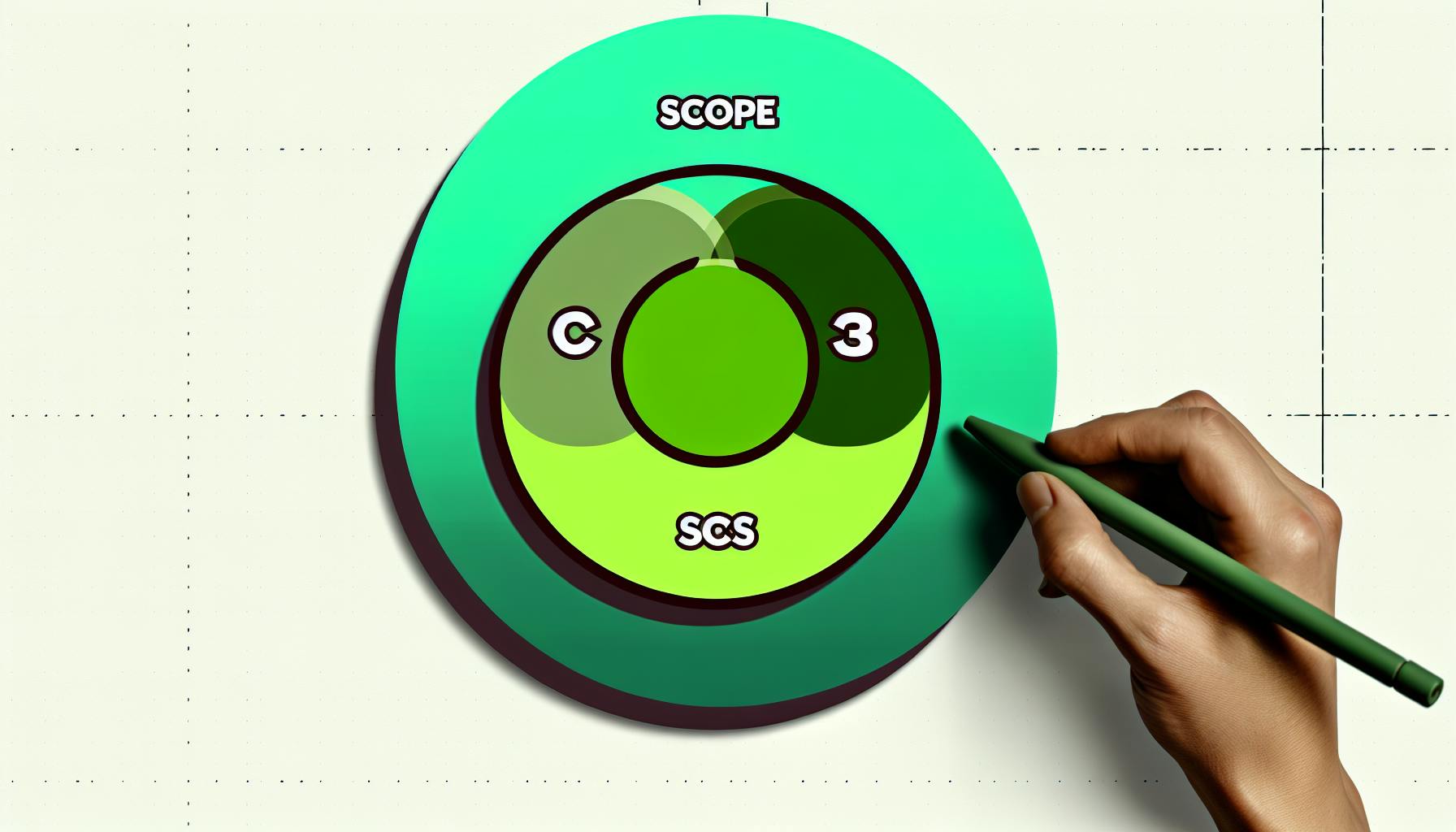Involving stakeholders in setting carbon reduction targets is crucial for small and medium-sized enterprises (SMEs). Here are the key steps to effectively engage stakeholders in this process:
-
Find Key People
- Identify and rank stakeholders based on their influence and interest in your company's carbon goals
- Prioritise those with high influence and interest, such as suppliers, customers, investors, and employees
-
Identify Key Environmental Issues
- Discuss sustainability concerns with stakeholders through surveys, workshops, or interviews
- Agree on top environmental priorities by categorising issues based on impact, likelihood, and relevance
-
Plan Data Collection
- Collaborate with stakeholders, especially supply chain partners, to gather accurate environmental data
- Explain the importance of data in measuring, managing, and reducing carbon emissions
- Report Transparently
-
Set and Meet Carbon Targets
- Develop achievable targets aligned with climate science and stakeholder input
- Involve suppliers in reducing emissions by educating, collaborating, and monitoring progress
By engaging stakeholders throughout the process, SMEs can build trust, credibility, and support for their sustainability initiatives, ultimately driving business success and environmental impact.
5 Tips for Good Stakeholder Engagement
Step 1: Find Key People
Identifying the right stakeholders is crucial in setting science-based carbon reduction targets. This involves mapping out all relevant internal and external groups who have a stake in your company's carbon goals.
Rank Stakeholder Impact and Interest
To determine the influence and interest of different stakeholders, you can use a stakeholder mapping tool like the power-interest matrix. This helps categorise stakeholders based on their level of influence and interest in your company's carbon issues.
| Stakeholder Group | Level of Influence | Level of Interest |
|---|---|---|
| Suppliers | High | Medium |
| Customers | Medium | High |
| Investors | High | High |
| Employees | Varying | High |
| Local Communities | Varying | High |
Prioritise People to Involve
Once you've identified and ranked your stakeholders, prioritise those who are most critical to involve in the target-setting process. This may include stakeholders with high levels of influence and interest, as well as those with high levels of interest.
By involving key stakeholders, you can ensure that your science-based targets are relevant, achievable, and aligned with the interests of all relevant stakeholders. This helps build trust, credibility, and support for your sustainability initiatives, ultimately driving business success and environmental impact.
Step 2: Identify Key Environmental Issues
This step is about engaging with stakeholders to identify the environmental issues that matter most to both your company and its stakeholders.
Discuss Sustainability Concerns
To identify key environmental issues, you need to have open and honest discussions with stakeholders. You can do this by conducting surveys, workshops, or interviews to gather information on their concerns and expectations. This helps you understand the environmental issues that are most important to your stakeholders.
For example, you can use the AA1000 Stakeholder Engagement Standard, which provides a practical framework for organising stakeholder engagement.
Agree on Top Environmental Priorities
Once you've gathered information from stakeholders, you can prioritise the environmental issues that matter most. You can do this by categorising issues based on their impact, likelihood, and relevance to your business.
For example:
| Environmental Issue | Impact | Likelihood | Relevance |
|---|---|---|---|
| Climate Change | High | High | High |
| Water Pollution | Medium | Medium | Medium |
| Biodiversity Loss | High | Medium | High |
By prioritising environmental issues, you can focus on the most critical areas that require attention and action. This helps ensure that your science-based targets are relevant, achievable, and aligned with the interests of all relevant stakeholders.
Remember, involving stakeholders in the target-setting process is crucial to building trust, credibility, and support for your sustainability initiatives. By engaging with stakeholders and prioritising environmental issues, you can drive business success and environmental impact.
sbb-itb-919600f
Step 3: Plan Data Collection
This step outlines how to gather the necessary data to measure and manage the company's carbon footprint with stakeholder collaboration.
Collaborate on Gathering Environmental Data
Collaborate with stakeholders, especially supply chain partners, to collect accurate environmental data. Identify the types of data needed, determine the sources of data, and establish a process for collecting and reporting data. Consider the following approaches:
- Conduct surveys or workshops with stakeholders to gather information on their environmental impacts and concerns
- Engage with suppliers to collect data on their operations, energy consumption, and waste management practices
- Utilise industry benchmarks and standards to estimate emissions and environmental impacts
- Implement data management systems to track and analyse environmental data
Explain Data Importance to Stakeholders
Inform stakeholders about the importance of data in setting and achieving carbon reduction targets. Educate them on:
- The role of data in measuring and managing environmental impacts
- The benefits of data-driven decision-making in reducing emissions and improving sustainability
- The importance of data accuracy and consistency in reporting and tracking progress
- The opportunities for stakeholder engagement and collaboration in data collection and analysis
By explaining the importance of data to stakeholders, companies can ensure that they are invested in the data collection process and are more likely to provide accurate and reliable data. This, in turn, can lead to more effective carbon reduction strategies and improved sustainability outcomes.
Data Collection Approaches
| Approach | Description |
|---|---|
| Surveys/Workshops | Gather information on stakeholders' environmental impacts and concerns |
| Supplier Engagement | Collect data on suppliers' operations, energy consumption, and waste management practices |
| Industry Benchmarks | Estimate emissions and environmental impacts using industry standards |
| Data Management Systems | Track and analyse environmental data |
Benefits of Data-Driven Decision-Making
| Benefit | Description |
|---|---|
| Improved Sustainability | Make informed decisions to reduce emissions and improve sustainability |
| Accurate Reporting | Ensure data accuracy and consistency in reporting and tracking progress |
| Stakeholder Engagement | Encourage stakeholder collaboration and investment in data collection and analysis |
| Effective Carbon Reduction | Develop more effective carbon reduction strategies and improve sustainability outcomes |
Step 4: Report Transparently
This step explains how to transparently report your company's sustainability performance, incorporating stakeholder feedback.
Choose a Suitable Reporting Framework
Select a reporting framework that aligns with your company's sustainability objectives and stakeholder expectations. Popular frameworks include:
| Framework | Description |
|---|---|
| Global Reporting Initiative (GRI) | Comprehensive approach to sustainability reporting |
| Sustainability Accounting Standards Board (SASB) | Industry-specific, focuses on financially material sustainability issues |
| Task Force on Climate-related Financial Disclosures (TCFD) | Specifically designed for climate-related disclosures |
Include Stakeholder Input in Reports
Stakeholder input is crucial in ensuring that sustainability reports are accurate, relevant, and useful. Engage with stakeholders throughout the reporting process to gather feedback and insights on your sustainability performance. This can be done through:
- Surveys
- Focus groups
- One-on-one interviews
Incorporate stakeholder feedback into your reports to provide a more nuanced understanding of your sustainability performance. This can be done by:
- Including quotes or testimonials from stakeholders
- Providing a summary of stakeholder feedback and how it has been addressed
By choosing a suitable reporting framework and incorporating stakeholder input, you can ensure that your sustainability reports are transparent, accurate, and useful for stakeholders. This can help build trust, improve sustainability performance, and drive long-term value creation.
Step 5: Set and Meet Carbon Targets
This step discusses how to work with stakeholders to set ambitious, science-based carbon reduction targets and collaborate to achieve them.
Develop Achievable Targets
To set effective targets, you need to:
- Assess your emissions: Identify areas of high emissions and prioritise reductions accordingly.
- Engage with stakeholders: Collaborate with suppliers, customers, and internal teams to gather input on target setting and implementation.
- Align with climate science: Ensure targets are consistent with the level of decarbonisation required to limit global warming to 1.5°C.
Involve Suppliers in Reducing Emissions
Suppliers play a critical role in reducing Scope 3 emissions. To involve suppliers in setting and achieving emission targets:
| Supplier Engagement | Description |
|---|---|
| Educate and incentivise suppliers | Provide training and resources to help suppliers understand the importance of carbon reduction and offer incentives for achieving targets. |
| Collaborate on target-setting | Work with suppliers to establish joint targets and develop a plan for achieving them. |
| Monitor and report progress | Regularly track and report on supplier progress towards targets, providing feedback and support as needed. |
By involving suppliers in the target-setting process, companies can drive meaningful reductions in Scope 3 emissions and make significant progress towards achieving their science-based targets.
Summary: Why Stakeholder Input Matters
Setting science-based carbon reduction targets is crucial for a decarbonised future. However, it's not a solo effort. Stakeholder input plays a vital role in this process. By engaging stakeholders, organisations can ensure that their targets are ambitious, achievable, and aligned with the needs of various groups.
Benefits of Stakeholder Input
Stakeholder input provides valuable insights into an organisation's operations, helping to:
- Identify areas of high emissions and prioritise reductions
- Develop targets consistent with the level of decarbonisation required to limit global warming to 1.5°C
- Build trust, credibility, and a strong foundation for achieving science-based targets
By involving stakeholders in the target-setting process, organisations can foster a sense of ownership and responsibility, leading to more effective implementation and better outcomes.



